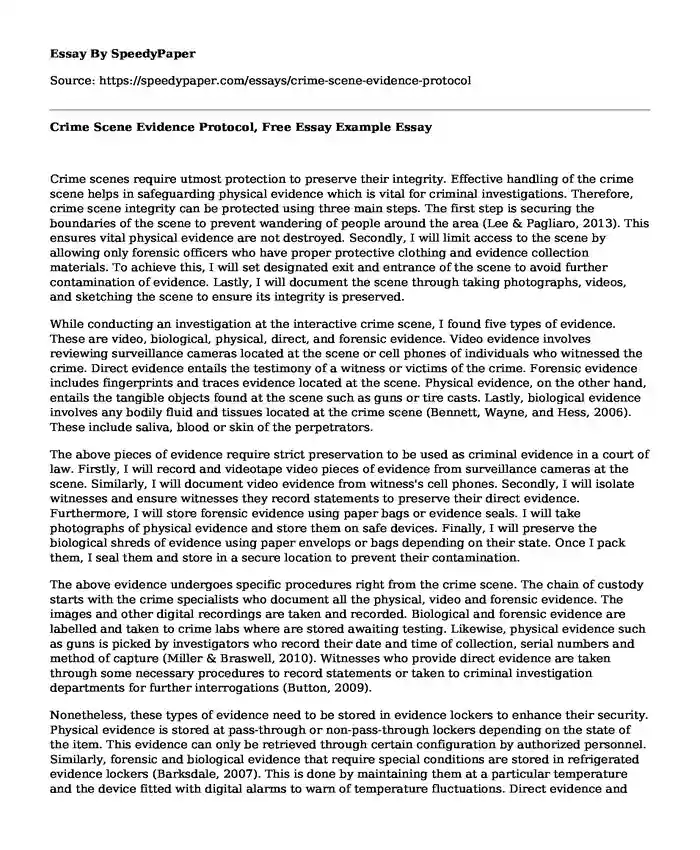
| Type of paper: | Essay |
| Categories: | Criminal law Police |
| Pages: | 3 |
| Wordcount: | 662 words |
Crime scenes require utmost protection to preserve their integrity. Effective handling of the crime scene helps in safeguarding physical evidence which is vital for criminal investigations. Therefore, crime scene integrity can be protected using three main steps. The first step is securing the boundaries of the scene to prevent wandering of people around the area (Lee & Pagliaro, 2013). This ensures vital physical evidence are not destroyed. Secondly, I will limit access to the scene by allowing only forensic officers who have proper protective clothing and evidence collection materials. To achieve this, I will set designated exit and entrance of the scene to avoid further contamination of evidence. Lastly, I will document the scene through taking photographs, videos, and sketching the scene to ensure its integrity is preserved.
While conducting an investigation at the interactive crime scene, I found five types of evidence. These are video, biological, physical, direct, and forensic evidence. Video evidence involves reviewing surveillance cameras located at the scene or cell phones of individuals who witnessed the crime. Direct evidence entails the testimony of a witness or victims of the crime. Forensic evidence includes fingerprints and traces evidence located at the scene. Physical evidence, on the other hand, entails the tangible objects found at the scene such as guns or tire casts. Lastly, biological evidence involves any bodily fluid and tissues located at the crime scene (Bennett, Wayne, and Hess, 2006). These include saliva, blood or skin of the perpetrators.
The above pieces of evidence require strict preservation to be used as criminal evidence in a court of law. Firstly, I will record and videotape video pieces of evidence from surveillance cameras at the scene. Similarly, I will document video evidence from witness's cell phones. Secondly, I will isolate witnesses and ensure witnesses they record statements to preserve their direct evidence. Furthermore, I will store forensic evidence using paper bags or evidence seals. I will take photographs of physical evidence and store them on safe devices. Finally, I will preserve the biological shreds of evidence using paper envelops or bags depending on their state. Once I pack them, I seal them and store in a secure location to prevent their contamination.
The above evidence undergoes specific procedures right from the crime scene. The chain of custody starts with the crime specialists who document all the physical, video and forensic evidence. The images and other digital recordings are taken and recorded. Biological and forensic evidence are labelled and taken to crime labs where are stored awaiting testing. Likewise, physical evidence such as guns is picked by investigators who record their date and time of collection, serial numbers and method of capture (Miller & Braswell, 2010). Witnesses who provide direct evidence are taken through some necessary procedures to record statements or taken to criminal investigation departments for further interrogations (Button, 2009).
Nonetheless, these types of evidence need to be stored in evidence lockers to enhance their security. Physical evidence is stored at pass-through or non-pass-through lockers depending on the state of the item. This evidence can only be retrieved through certain configuration by authorized personnel. Similarly, forensic and biological evidence that require special conditions are stored in refrigerated evidence lockers (Barksdale, 2007). This is done by maintaining them at a particular temperature and the device fitted with digital alarms to warn of temperature fluctuations. Direct evidence and video evidence recorded are stored in digital lockers which are equipped with fingerprint security system. Deposit and retrieval of these pieces of evidence are only carried out by authorized individuals (Barksdale, 2007).
References
Barksdale, L. (2007). Crime Scene Investigation Protocol. The state of the art, 2-14.
Bennett, Wayne W. and Karen M. Hess. (2006). Criminal Investigations (8th ed). Belmont, CA: Wadsworth Publishing.
Button, D. (2009). Evidence Collection, Preservation, and Chain of Custody. National Association of Subrogation Professionals "Subrogation" Magazine, 1-15.
Lee, H. C., & Pagliaro, E. M. (2013). Forensic evidence and crime scene investigation. Journal of Forensic Investigation, 1(1), 1-5.
Miller, L. S., & Braswell, M. C. (2010). Crime scene investigation. Elsevier Science,1-22.
Cite this page
Crime Scene Evidence Protocol, Free Essay Example. (2022, Mar 11). Retrieved from https://speedypaper.com/essays/crime-scene-evidence-protocol
Request Removal
If you are the original author of this essay and no longer wish to have it published on the SpeedyPaper website, please click below to request its removal:
- Application for the Assistant Management Position. Free Essay.
- Art Essay Example: Glass and Fruit by George Braque
- Essay Sample about Leadership Experiences
- Article Review Essay Sample: Wilderness Conservation and the Reach of the State
- Free Essay Example on Cat Grooming and Vomiting
- Free Essay Example: Animations and How It Is Perceived
- Paper Example on the Pneumococcal Vaccine
Popular categories




